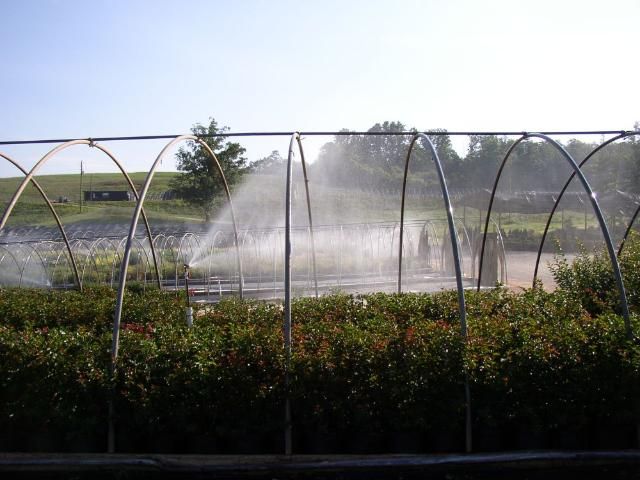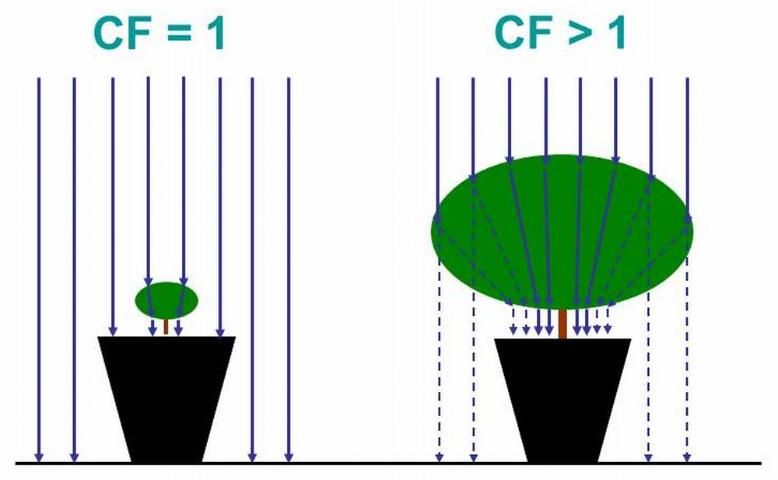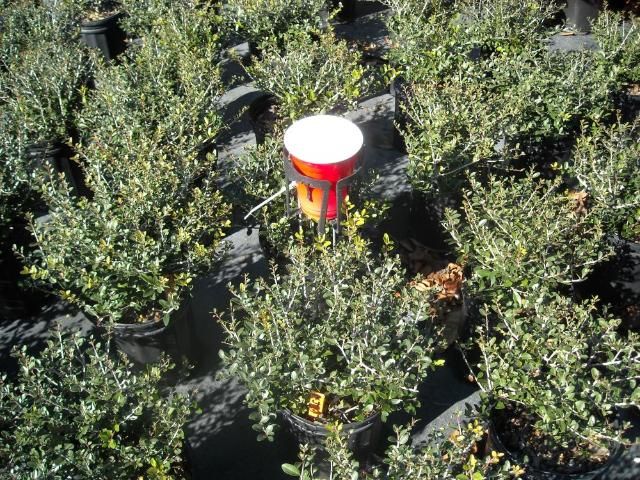Container nurseries irrigate to resupply water lost through evapotranspiration (https://edis.ifas.ufl.edu/ae256). Evapotranspiration (ET) rates for container-grown plants are affected by plant size, container size and spacing, and weather. Because plant size changes slowly, weather is the primary factor affecting day-to-day changes in ET water loss from containers. Water deficits in container substrates can be measured directly by weighing, indirectly with sensors, or estimated with predictive models. When determining the irrigation requirement based on measured or predicted water deficits caused by ET, one needs to also consider the irrigation system's ability to deliver water to the container substrate (Figure 1). For this, two additional factors must be considered: 1) the plant's capacity to channel water into the container that would otherwise fall between containers (capture factor), and 2) the irrigation system's ability to supply water uniformly within the irrigation zone (distribution uniformity). This publication describes how these factors can be measured so that irrigation requirements can be determined in the container nursery.

Credit: Jeff Million and Saunders Brothers Nursery
Three factors determining the irrigation requirement for container-grown crops
Evapotranspiration (ET) is the amount of water lost due to plant transpiration and substrate evaporation. It represents the amount of water that needs to be resupplied through irrigation (or rain). ET is affected by weather and changes daily.
Capture Factor (CF) is a measure of the plant canopy’s capacity to channel sprinkler irrigation water into the container that would otherwise fall between containers. As CF changes, irrigation amounts can be adjusted accordingly.
Distribution Uniformity (DU) is a measure of the sprinkler irrigation system's ability to deliver water uniformly throughout the irrigated area. As uniformity decreases, irrigation rates must be increased accordingly if all areas within the irrigation zone are to receive the recommended amount of water.
Measuring container ET
Evapotranspiration is water evaporated from leaf and substrate surfaces and is typically measured for a 24-hour period. The potential rate of ET is primarily affected by weather (solar radiation and temperature). Actual ET is less than potential ET when plant cover is not dense enough to intercept all incoming solar radiation. In container nurseries, actual ET is affected by plant size and container spacing. Container ET can be measured directly by weighing well-watered containers predawn and then again at the end of the day.
Procedures for measuring container ET
- Select and label representative containers and measure container diameter.
- Weigh containers early in the morning after irrigation and drainage but before appreciable water loss has occurred (record weight to nearest 0.01 kg). It is important that containers are well-watered so that ET during the day is not limited because of insufficient water in the container.
- Place containers back in production area in normal arrangement for the rest of the day.
- Reweigh same containers at the end of the day (record weight to nearest 0.01 kg).
- Subtract weight at end of day from weight in morning. Container ET is equal to the weight loss during the day. The density of water (1 g = 1 cm3; 1 kg = 1000 cm3) is used to convert weight loss to an equivalent volume of water. Volume of water lost from container is then converted to an equivalent depth of water based on the top area of the container. Finally, container ET units can be converted from cm to inch.
Example ET Calculations
Data
Morning weight = 11.45 kg
Evening weight = 10.30 kg
Container diameter = 11 inch
Calculate container top area
a) Container diameter = 11 inch * 2.54 cm/inch = 27.9 cm
b) Container radius = 27.9 cm ÷ 2 = 14.0 cm
c) Container top area = pr2 = 3.14159 * 14.02 = 616 cm2
Calculate container ET
a) Container ET = [11.45 - 10.30 kg/container] * 1000 cm3/kg = 1150 cm3/container
b) Container ET = 1150 cm3 ÷ 616 cm2 = 1.87 cm
c) Container ET = 1.87 cm ÷ 2.54 cm/inch = 0.74 inch
Measuring CF
The capture factor is the ratio of water captured by a container with a plant in it compared to the amount of water that would be captured by the same container without a plant growing in it. CF values >1 indicate the plant is channeling water into the container that would otherwise fall between containers (Figure 2). For example, a CF = 2 indicates that twice as much water will enter the container than indicated by irrigation depth alone. In general, plant species with upright-spreading growth habits exhibit greater CF values than broad-spreading growth habits. CF values typically increase as plant size increases.

Credit: Jeff Million and Bart Schutzman
Procedures for measuring CF
- Select and label representative containers and measure container diameter.
- Place each container in a similar-sized empty container lined with a plastic bag to collect leachate.
- Weigh each container assembly immediately prior to irrigation (record weight to nearest 0.01 kg).
- Put containers back in production area in normal arrangement.
- Place cups to capture irrigation water in the vicinity of test containers (Figure 3).
- Apply irrigation (0.4–0.6 inch recommended).
- Reweigh each container assembly after irrigation and before significant ET has occurred (record weight to nearest 0.01 kg).
- Measure volume of irrigation water collected in each cup (cm3).

Credit: Jeff Million
Example CF calculations
Data
Pre-irrigation weight = 10.60 kg/container
Post-irrigation weight = 11.85 kg/container
Container diameter = 10 inch
Irrigation cup diameter = 9.6 cm
Average volume of water collected in irrigation cups = 95 cm3
Calculate container top area
a) Container diameter = 10 inch * 2.54 cm/inch = 25.4 cm
b) Container radius = 25.4 cm ÷ 2 = 12.7 cm
c) Container top area = pr2 = 3.14159 * 12.72 = 507 cm2
Calculate irrigation water applied
a) Irrigation collection cup radius = 9.6 cm ÷ 2 = 4.8 cm
b) Irrigation collection cup top area = pr2 = 3.14159 * 4.82 = 72.4 cm2
c) Irrigation depth applied = 95 cm3 ÷ 72.4 cm2 = 1.31 cm
Calculate irrigation water captured
a) Irrigation volume captured = [11.85 - 10.60 kg] * 1000 cm3/kg = 1250 cm3
b) Irrigation depth captured = 1250 cm3 ÷ 507 cm2 = 2.47 cm
Calculate CF
CF = irrigation depth captured ÷ irrigation depth applied = 2.47 cm ÷ 1.31 cm = 1.9
Measuring DU
An additional adjustment to the irrigation requirement considers the irrigation system's distribution uniformity. Irrigation systems, especially high-pressure sprinkler systems, typically do not apply water uniformly throughout the irrigated area. If irrigation is based on the average irrigation delivery rate of the system (inch/hour), there will be areas within the irrigation zone that receive less water than average and areas that will receive more than average. DU can be measured and irrigation rates adjusted accordingly so that all areas within the irrigation zone receive, at a minimum, the desired amount of water.
Procedures for measuring DU
- Distribute irrigation collection cups uniformly throughout all areas of the irrigation zone. The more cups used, the more accurate the DU measurement. In general, 20 cups per 1000 ft2 is an adequate density for most situations. Be sure collection cups are above the plant canopy if the test area contains plants (Figure 3).
- Turn on the irrigation system so that approximately 0.5 inch of water is applied. Irrigate predawn or early morning when winds are calm and sun is not bright.
- Use a graduated cylinder to measure the volume of water collected in each cup. Record volume in each cup to the nearest 1 cm3 (1 ml = 1 cm3). Making a map of the irrigation area with location of collection cups allows for later identification and troubleshooting of areas of poor uniformity.
- Measure collection cup diameter to nearest 0.1 cm.
- Calculate DU as the average volume of the lowest 25% of the collection cups divided by the average volume of all collection cups. The average irrigation application rate can be calculated if the duration of application is also recorded.
Example DU calculations
Data
Total number of cups = 40
Collection cup diameter = 9.0 cm
Average volume of water collected in all 40 irrigation cups = 76 cm3
Average volume of water collected in the 10 lowest cups (lowest 25%) = 61 cm3
Irrigation duration = 40 minutes
Calculate irrigation delivery rate
a) Collection cup radius = 9.0 cm ÷ 2 = 4.5 cm
b) Collection cup area = pr2 = 3.14159 * 4.52 = 63.6 cm2
c) Irrigation depth for 40 min irrigation = 76 cm3 ÷ 63.6 cm2 = 1.19 cm
d) Irrigation delivery rate = 1.19 cm ÷ 40 min * 60 min/hour ÷ 2.54 cm/inch = 0.70 inch/hour
Calculate DU
DU = avg. volume in lowest 25% of cups ÷ avg. volume in all cups = 61 cm3/76 cm3 = 0.80 = 80%
Calculating irrigation requirement
The daily irrigation requirement can now be calculated based on container ET, CF, and DU measurements.
Example calculations
Data
Container ET = 0.74 inch
CF = 1.9
DU = 80%
Irrigation rate = 0.70 inch/hour
Irrigation requirement = (container ET ÷ CF) * (100% ÷ DU) = (0.74 inch ÷ 1.9) * (100 ÷ 80) = 0.49 inch
If the irrigation delivery rate = 0.70 inch/hour, then
Irrigation run time = 0.49 inch ÷ 0.70 inch/hour * 60 min/hour = 42 min